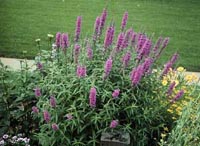Resource Library
Plant of the Week: Morden Pink Loosestrife
The University of Arkansas System Division of Agriculture does not promote, support or recommend plants featured in "Plant of the Week." Please consult your local Extension office for plants suitable for your region.
Plant of the Week
Morden Pink Loosestrife
Latin: Lythrum virgatum

Gardeners are, by and large, a honest set of folk. But deep down, a bit of larceny
lurks in us all. Who amongst us has not pinched a cutting here or pocketed a seed
capsule there?
Justification for such petty pilferage is easy to come by, and most of us feel it
does no harm, but Big Brother does not always agree. State regulatory authorities
at the Arkansas State Plant Board have banned two garden plants in recent years as
noxious weeds. Like a small quantity of marijuana in California, it is not illegal
to have the plant, but it is illegal to sell or transport it.
Morden Pink Loosestrife, a member of the loosestrife family to which crape myrtle
belongs, is a semi-woody perennial that grows to four feet in height and has willow-like
leaves two to four inches long. In midsummer it produces 1-inch wide pink flowers
crowded onto an upright spike that’s 6-8 inches long.
Morden Pink, developed by Dr. Skinner at the Agricultural Research Station in Manitoba,
Canada, has been marketed since 1937 as a male sterile sport that’s not supposed to
set seed. Apparently, when grown in isolation by itself, it is seedless (if it really
is the original strain); but when pollinated by other related species, it too will
bear seed.
Both this species and the look-alike species purple loosestrife (L. saliciaria) are native to the Old World and have become established as waterway weeds in the
northern states. In the late 1980's, the US Fish and Wildlife Service, aided by Ducks
Unlimited, began a campaign to outlaw planting Lythrum and eradicate established stands.
In the cooler north country loosestrife has escaped cultivation and clogs waterways
and out competes less aggressive native species. Its seeds are not eaten by any of
the native wildlife species, thus reducing the food supply for wild fowl. In 1990,
Arkansas, fearing that loosestrife would escape here, banned all Lythrum species as
illegal for sale in the state.
How big a threat is loosestrife to our wild areas, and was banning all species of
Lythrum a knee jerk reaction to a perceived problem? The tenor of the argument went
primarily along the "better safe than sorry" line, and in the big picture that is
probably the most prudent approach to take.
I grew a strain of L. salicaria in a dry site in Fayetteville in about 1980 and observed no reseeding in the field
under typical dryland conditions. One of these plants made its way to my garden at
home. That plant was ringed by a number of seedlings the following spring, but none
of these seedlings survived in my rather dry garden. If the site had been more moist,
they probably would have survived.
Even supposedly sterile strains such as Morden Pink present a problem because too
often the plant being sold is not what it is supposed to be. This mixup in cultivars
is a never-ending problem in the nursery trade. The causes of name-mixing are varied,
but it often is due to a nurseryman guessing that the plant they have is the same
as whatever plant is most common in the trade at that time. Often the guess is wrong
and selections become endlessly confused.
As gardeners, we want to do our part to insure that the natural habitat is not overrun
by an aggressive invader. Foregoing the ability to purchase loosestrife is a small
price to pay if it prevents the spread of the next dandelion. While relatively few
of our common weeds were introduced as ornamentals, it can and does happen, so prudence
is probably the best approach.
By: Gerald Klingaman, retired
Extension Horticulturist - Ornamentals
Extension News - July 21, 2000
The University of Arkansas System Division of Agriculture does not maintain lists of retail outlets where these plants can be purchased. Please check your local nursery or other retail outlets to ask about the availability of these plants for your growing area.